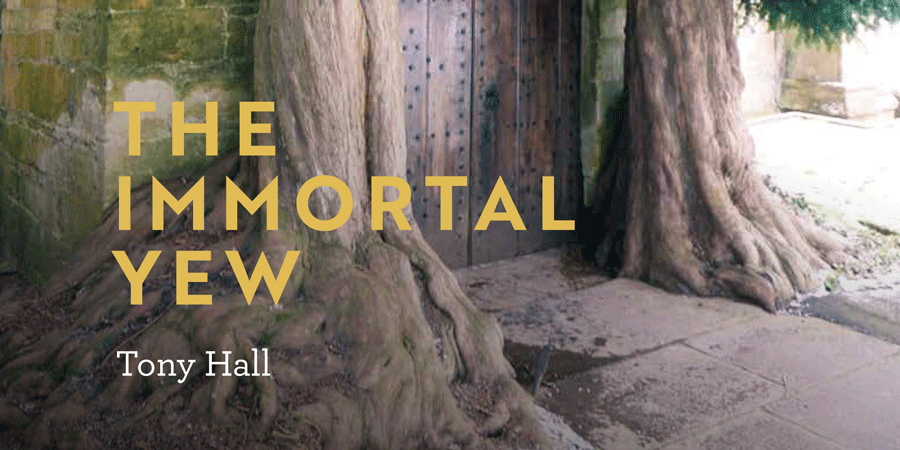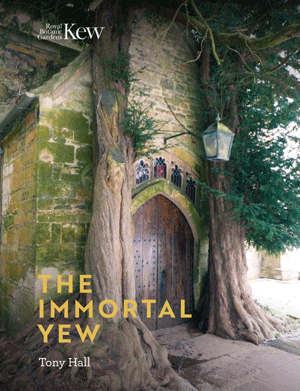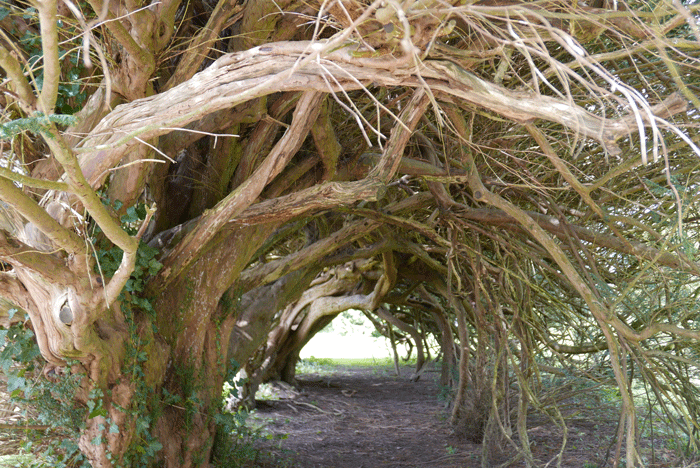Review: The Immortal Yew
 The Magna Carta was signed under one, William Wordsworth wrote a famous poem about one and the longbows so decisive at Agincourt were made from the wood of one. We are talking about the yew or to be more precise the Common or European Yew, Taxus baccata – those ancient and noble trees that are so much part of our heritage and history.
The Magna Carta was signed under one, William Wordsworth wrote a famous poem about one and the longbows so decisive at Agincourt were made from the wood of one. We are talking about the yew or to be more precise the Common or European Yew, Taxus baccata – those ancient and noble trees that are so much part of our heritage and history.
In his new book, ‘The Immortal Yew‘, Tony Hall has covered the length and breadth of Britain and Ireland to bring together an amazing collection of individual yew trees. He charts the relationship of the yew in mythology, religion and folklore, their various uses for instruments, wood turning and furniture making, not to mention those fabled longbows and the yew’s value in medicine.
 When we think of the yew we invariably think of churchyards – for today we associate them with their sacred significance – many of the oldest yews, however, predate the churches they stand alongside. The yew was worshipped by the pagans for its links with death and re-birth as an emblem of resurrection. In Tudor times it was customary to tie sprigs of yew to coffins and the tree has long been used as a church decoration during Palm Sunday celebrations. Often you will find one yew at the Church gate and one near the door.
When we think of the yew we invariably think of churchyards – for today we associate them with their sacred significance – many of the oldest yews, however, predate the churches they stand alongside. The yew was worshipped by the pagans for its links with death and re-birth as an emblem of resurrection. In Tudor times it was customary to tie sprigs of yew to coffins and the tree has long been used as a church decoration during Palm Sunday celebrations. Often you will find one yew at the Church gate and one near the door.
As Tony points out in the book, ancient yews, both churchyard trees and those in woodlands, do have an air of mystery about them and I was delighted to see that he has included the old yew in Holeslack Woods, Heslington, Cumbria. A stunning and yes definitely mysterious example as well as several other Cumbrian stars.
One of only three native conifers in the UK, the yew is easily distinguishable by its very dark green, needle-like, forward facing leaves. Tony points out in the Introduction that the species is believed to be at least 15 million years old and certainly the oldest living things in the UK are yew trees as they can outlive the English oak (Quercus robur) by as much as 2,000 years.
William Wordsworth’s yew can be found in Lorton, Cumbria, described by Tony as being as rugged as the Cumbrian fells that surround it. George Fox, the founder of the Quakers, preached under it in 1653 and John Wesley, the founder of Methodism is also reputed to have done so.
 The churchyard of St Winefride’s Church, Gwytherin, Conway, is home to three ancient yews and also four standing stones. Legend has it that this site tells the story of Gwenfrewi (St Winefride) who scorned the advances of Prince Caradoc and was beheaded. Her head is said to have rolled down a hill, triggering an earthquake which caused the ground to open up and water gush out. Winefride was then brought back to life. Today, this well is still popular with visitors who believe in its healing waters. (pictured right: the yew at St Mary’s, Astbury).
The churchyard of St Winefride’s Church, Gwytherin, Conway, is home to three ancient yews and also four standing stones. Legend has it that this site tells the story of Gwenfrewi (St Winefride) who scorned the advances of Prince Caradoc and was beheaded. Her head is said to have rolled down a hill, triggering an earthquake which caused the ground to open up and water gush out. Winefride was then brought back to life. Today, this well is still popular with visitors who believe in its healing waters. (pictured right: the yew at St Mary’s, Astbury).
The clipped yews of Painswick are included, of which there are reputed to be some 99. These yews are around 300 years old having been planted in avenues from the lychgate of the churchyard and they are clipped every year.
In the churchyard of Fortingall Church, Aberfeldy, is the famous Fortingall Yew. Reportedly the oldest tree in Europe, said to be between 2,000 and 3,000 years. The area surrounding this yew is rich in ancient archaeological sites and is the geographical centre of Scotland.
The book starts with a useful timeline of the European yew and includes chapters on the Natural history of the yew, Dating ancient yews, Religion and folklore, Uses, Churches and churchyard features and Churchyard yews. The description of each yew included then follows. One niggle here is that I would have appreciated an index to the yews included on the contents page for easy reference, however, they are in alphabetical order throughout the book. His descriptions of each tree and their environments are well written conveying the special quality of the tree as well as its history and folklore making fascinating reading.
 (pictured above – The Aberglasney Yew Tunnel)
(pictured above – The Aberglasney Yew Tunnel)
There is a map of the back showing the location of featured yews and where applicable on each yew description the author has included directions where he felt it necessary. The reader will find 75 publicly accessible yews are included, with details on their appearance, location and folklore as well as photographs.
Author, Tony Hall, is manager of the Arboretum and Gardens at the Royal Botanic Gardens, Kew, where he has worked for the last 17 years. It is timely that an authoritative book should be written about this most iconic of trees by an expert who knows and loves them.
‘The Immortal Yew‘ by Tony Hall is published in hardback by The Royal Botanic Gardens, Kew (Kew Publishing) at £25.00 (US$35).
A review copy of this publication was kindly supplied by the publishers.

